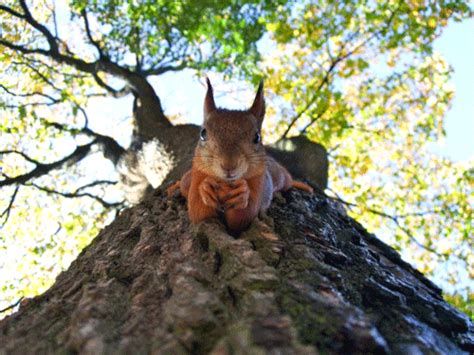
Squirrels across several states are exhibiting unusually erratic behavior, prompting wildlife officials to issue warnings about potential causes ranging from premature mating season activity to neurological diseases. Reports include squirrels approaching humans without fear, appearing disoriented, and displaying aggressive tendencies, raising concerns among residents and experts alike.
Wildlife experts are investigating a surge in reports of atypical squirrel activity, with concerns spanning multiple states and encompassing a range of bizarre behaviors. According to authorities, squirrels have been observed exhibiting behaviors such as approaching humans without fear, disorientation, unprovoked aggression, and difficulty with coordination. These unusual activities have triggered advisories from local and state agencies, urging residents to exercise caution and report any sightings of squirrels behaving erratically.
The specific geographic areas experiencing this phenomenon include, but are not limited to, regions in the Northeastern and Midwestern United States, though precise locations have not been uniformly documented across all reporting agencies. The surge in unusual behavior has been noted particularly over the past few weeks, with reports increasing in frequency. Experts suggest that the underlying causes could be multifaceted, ranging from environmental factors affecting the animals’ natural cycles to the potential spread of diseases impacting their neurological functions.
“We’ve received numerous calls about squirrels acting strangely,” said a spokesperson for the Department of Natural Resources (DNR) in one affected state, emphasizing the importance of public awareness and vigilance. “They’re approaching people, seeming confused, and sometimes even becoming aggressive for no apparent reason. We advise residents to maintain a safe distance from wildlife and to avoid any direct contact with these animals.”
The potential causes of this unusual behavior are currently under investigation. One hypothesis is that the squirrels are experiencing an early or disrupted mating season due to unseasonably warm weather patterns. Such disruptions can lead to heightened aggression and disorientation as the animals’ natural behaviors are thrown off balance. Another theory suggests that the unusual behavior could be indicative of diseases, such as rabies or other neurological ailments, affecting the squirrel population. While rabies in squirrels is relatively rare, officials are not ruling out the possibility. Further testing and analysis are underway to determine whether any infectious diseases are contributing to the observed symptoms.
The impact of these unusual squirrel behaviors extends beyond the immediate concerns of public safety. Ecological implications are also being considered, as altered behavior patterns could affect the squirrels’ foraging habits, reproduction rates, and overall population dynamics. Squirrels play a critical role in seed dispersal and forest regeneration, and any significant disruption to their behavior could have cascading effects on local ecosystems.
Residents are urged to take several precautions to minimize risks associated with encountering these unusually behaving squirrels. Avoiding direct contact is paramount, as is refraining from feeding squirrels or leaving food sources accessible. Pet owners should keep their animals indoors or on a leash to prevent potential interactions with affected squirrels. Any sightings of squirrels exhibiting unusual behavior should be reported to local animal control or wildlife authorities promptly.
The investigation into this phenomenon is ongoing, with state and local agencies collaborating to gather data and analyze potential causes. Experts are collecting samples for laboratory testing to identify any underlying diseases or environmental factors contributing to the unusual behavior. Public awareness campaigns are being launched to educate residents about the importance of reporting sightings and taking necessary precautions. The aim is to develop a comprehensive understanding of the issue and implement strategies to mitigate potential risks to both human and wildlife populations.
This unusual surge in erratic squirrel behavior serves as a reminder of the complex interactions between wildlife, environmental factors, and human populations. Continued monitoring, research, and public awareness efforts are essential for addressing such issues effectively and ensuring the health and safety of both communities and ecosystems. The coming weeks will be critical in understanding the full scope of the situation and determining the appropriate course of action to address these emerging concerns.
The increase in reported cases warrants a detailed examination of potential contributing factors. Environmental changes, such as habitat loss and fragmentation, can put stress on wildlife populations, making them more susceptible to disease and behavioral abnormalities. Climate change, with its associated extreme weather events, can also disrupt natural cycles and affect the availability of food and resources. These factors, combined with the potential for disease outbreaks, can have significant impacts on animal behavior and population health.
The role of human activities in influencing wildlife behavior cannot be overlooked. Urbanization, with its encroachment on natural habitats, can bring wildlife into closer contact with humans, increasing the likelihood of interactions and potential conflicts. The feeding of wildlife, while often well-intentioned, can disrupt natural foraging behaviors and make animals more dependent on human sources of food. This can lead to changes in behavior, such as increased boldness and aggression, as animals become more accustomed to human presence.
The investigation into the unusual squirrel behavior will involve a multidisciplinary approach, bringing together experts from various fields to analyze the data and develop informed recommendations. Wildlife biologists, veterinarians, ecologists, and public health officials will collaborate to assess the potential causes and consequences of the phenomenon. This collaborative effort is essential for developing a comprehensive understanding of the issue and implementing effective management strategies.
As the investigation progresses, ongoing communication with the public will be crucial. Regular updates on the findings, along with practical advice on how to minimize risks, will help to keep residents informed and engaged. Public awareness campaigns can also help to dispel myths and misconceptions about wildlife behavior, promoting a more informed and responsible approach to coexistence.
The recent reports of unusual squirrel behavior highlight the importance of monitoring wildlife populations and addressing potential threats to their health and well-being. By staying vigilant, conducting thorough investigations, and engaging the public in conservation efforts, we can help to ensure the long-term health and resilience of our ecosystems. The situation serves as a reminder of the interconnectedness of all living things and the need for a holistic approach to environmental management.
“We are actively monitoring the situation and working with local authorities to gather more information,” stated a representative from the Wildlife Management Division, underscoring the commitment to addressing these concerns promptly and effectively. The collaborative approach underscores the seriousness with which the issue is being handled and the determination to find answers and implement appropriate measures.
The current situation also brings to light the importance of understanding animal behavior in the context of environmental changes. As human activities continue to impact ecosystems around the world, wildlife populations are facing increasing challenges. Understanding how these challenges affect animal behavior is essential for developing effective conservation strategies and mitigating potential risks to both human and wildlife populations.
The investigation into the unusual squirrel behavior will also involve an assessment of the potential economic impacts of the phenomenon. Changes in wildlife populations can have significant implications for agriculture, tourism, and other sectors that rely on healthy ecosystems. Understanding these economic impacts is essential for developing comprehensive management plans that take into account the needs of both communities and the environment.
As the investigation continues, it is important to remember that squirrels are an integral part of our ecosystems, playing a vital role in seed dispersal and forest regeneration. While it is important to take precautions to protect public safety, it is also important to recognize the value of these animals and to work towards solutions that promote their long-term health and well-being. The current situation provides an opportunity to learn more about squirrel behavior and ecology, and to develop more effective strategies for managing wildlife populations in the face of environmental change.
The focus remains on gathering data, conducting research, and engaging the public in efforts to address the unusual squirrel behavior. By working together, we can develop a comprehensive understanding of the issue and implement strategies to protect both human and wildlife populations. The situation serves as a reminder of the importance of responsible environmental stewardship and the need for ongoing vigilance in the face of emerging challenges.
Another aspect of the investigation is focusing on potential toxins or pollutants that could be affecting the squirrels’ neurological systems. Environmental contamination can have subtle but significant impacts on animal behavior, and it is important to rule out this possibility. Samples of soil, water, and vegetation are being collected and analyzed to determine whether any harmful substances are present. This comprehensive approach to the investigation reflects the complexity of the issue and the commitment to finding the underlying causes of the unusual squirrel behavior.
Furthermore, there’s consideration being given to the potential impact of human-provided food sources on squirrel behavior. While some people enjoy feeding squirrels, doing so can disrupt their natural foraging habits and lead to dependence on human sources of food. This can result in increased boldness, aggression, and other behavioral changes. Experts are advising against feeding squirrels and encouraging residents to remove any potential food sources from their properties. This is an important step in promoting more natural and sustainable squirrel behavior.
The collaborative effort between state and local agencies is crucial for effectively addressing the unusual squirrel behavior. By sharing information, resources, and expertise, these agencies can work together to develop a comprehensive understanding of the issue and implement appropriate management strategies. This collaborative approach underscores the importance of interagency cooperation in addressing complex environmental challenges.
“We urge the public to remain calm and to report any unusual squirrel behavior to their local animal control or wildlife authorities,” emphasized the DNR spokesperson, reiterating the importance of public cooperation in addressing the situation. By working together, we can protect both human and wildlife populations and ensure the long-term health and resilience of our ecosystems. The coming weeks will be critical in understanding the full scope of the situation and determining the appropriate course of action to address these emerging concerns.
The investigation also involves analyzing historical data on squirrel populations and behavior patterns. By comparing current observations with historical trends, experts can gain a better understanding of the factors that may be contributing to the unusual behavior. This historical perspective is essential for developing informed management strategies and predicting potential future trends.
In addition to the immediate concerns about public safety and wildlife health, the unusual squirrel behavior also raises broader questions about the impact of human activities on ecosystems. As human populations continue to grow and expand, wildlife populations are facing increasing challenges. Understanding these challenges and developing strategies to mitigate their impacts is essential for ensuring the long-term health and sustainability of our planet.
The focus remains on gathering data, conducting research, and engaging the public in efforts to address the unusual squirrel behavior. By working together, we can develop a comprehensive understanding of the issue and implement strategies to protect both human and wildlife populations. The situation serves as a reminder of the importance of responsible environmental stewardship and the need for ongoing vigilance in the face of emerging challenges.
The state’s wildlife agency is preparing to implement additional monitoring programs to track squirrel populations and behavior patterns more closely. These programs will help to detect any further changes in behavior and to assess the effectiveness of management strategies. Early detection is crucial for addressing potential problems before they become more widespread.
Further research is planned to investigate the potential role of climate change in influencing squirrel behavior. Climate change can disrupt natural cycles and affect the availability of food and resources, which can have significant impacts on wildlife populations. Understanding these impacts is essential for developing effective conservation strategies.
The situation serves as a reminder of the importance of protecting and preserving natural habitats. Habitat loss and fragmentation can put stress on wildlife populations, making them more susceptible to disease and behavioral abnormalities. By protecting and restoring natural habitats, we can help to ensure the long-term health and resilience of our ecosystems.
The ongoing investigation underscores the importance of a comprehensive and collaborative approach to addressing complex environmental challenges. By working together, state and local agencies, experts from various fields, and the public can develop a comprehensive understanding of the issue and implement strategies to protect both human and wildlife populations. The situation serves as a reminder of the interconnectedness of all living things and the need for a holistic approach to environmental management.
The emphasis continues to be on gathering information, conducting research, and engaging the public in efforts to address the unusual squirrel behavior. By working together, we can develop a comprehensive understanding of the issue and implement strategies to protect both human and wildlife populations. The situation serves as a reminder of the importance of responsible environmental stewardship and the need for ongoing vigilance in the face of emerging challenges.
Frequently Asked Questions (FAQ)
Q1: What kind of strange behaviors are squirrels exhibiting?
A1: Squirrels have been reported approaching humans without fear, appearing disoriented or confused, displaying unprovoked aggression, and exhibiting difficulties with coordination or movement. “They’re approaching people, seeming confused, and sometimes even becoming aggressive for no apparent reason,” according to a Department of Natural Resources (DNR) spokesperson.
Q2: What could be causing these unusual squirrel behaviors?
A2: Experts are investigating several potential causes. One possibility is an early or disrupted mating season, potentially triggered by unseasonably warm weather. Another concern is the potential presence of diseases affecting their neurological functions, though rabies in squirrels is rare. Environmental toxins or pollutants are also being considered as possible factors.
Q3: What should I do if I encounter a squirrel behaving strangely?
A3: The primary advice is to avoid direct contact with the animal. Do not attempt to feed it or approach it. Keep pets indoors or on a leash to prevent interactions. Report the sighting to your local animal control or wildlife authorities as soon as possible. The DNR spokesperson stated that residents should “maintain a safe distance from wildlife and to avoid any direct contact with these animals.”
Q4: Are there any risks to humans or pets from these squirrels?
A4: There is a potential risk, though generally low. Aggressive behavior could lead to bites or scratches. While rabies is uncommon in squirrels, it’s crucial to avoid contact with any animal exhibiting unusual behavior. Pets should be kept away to prevent any potential conflicts.
Q5: What are authorities doing to address this situation?
A5: State and local agencies are collaborating to investigate the cause of the unusual behavior. They are collecting samples for laboratory testing to identify any underlying diseases or environmental factors. Public awareness campaigns are being launched to educate residents about the importance of reporting sightings and taking necessary precautions. The Wildlife Management Division stated they are “actively monitoring the situation and working with local authorities to gather more information.”
The issue extends to the potential long-term consequences for the broader ecosystem. As key seed dispersers, squirrels play a crucial role in forest regeneration. Any significant disruption to their behavior or population could have cascading effects on plant life and other animal species. The altered foraging habits could impact the distribution of plant seeds, affecting the composition and health of forests. This highlights the intricate web of ecological relationships and the importance of understanding the potential ramifications of unusual wildlife behavior.
The investigation will also delve into the genetic diversity of the affected squirrel populations. Reduced genetic diversity can make populations more vulnerable to diseases and environmental changes. By analyzing the genetic makeup of the squirrels, researchers can gain insights into their overall health and resilience. This information can be used to develop targeted conservation strategies aimed at preserving genetic diversity and ensuring the long-term survival of the populations.
A critical component of the investigation involves assessing the nutritional status of the squirrels. Malnutrition can weaken the immune system and make animals more susceptible to diseases. Researchers will analyze the diet of the squirrels to determine whether they are getting adequate nutrition. Factors such as habitat loss, food scarcity, and environmental contamination can all contribute to malnutrition in wildlife populations.
The use of pesticides and herbicides in urban and agricultural areas is also being examined as a potential contributing factor. These chemicals can have toxic effects on wildlife, affecting their neurological systems and behavior. Researchers are collecting samples of soil, water, and vegetation to test for the presence of pesticides and herbicides. This information will help to determine whether exposure to these chemicals is contributing to the unusual squirrel behavior.
The investigation will also consider the potential role of stress in influencing squirrel behavior. Stress can be caused by a variety of factors, including habitat loss, overcrowding, and exposure to predators. Chronic stress can weaken the immune system and lead to behavioral abnormalities. Researchers are studying the physiological and behavioral responses of squirrels to stress to determine whether it is a contributing factor to the unusual behavior.
The issue also underscores the importance of public education and outreach. Many people are unaware of the potential risks associated with feeding wildlife or interacting with animals that are exhibiting unusual behavior. Public education campaigns can help to raise awareness of these risks and promote responsible behavior. By educating the public, we can help to protect both human and wildlife populations.
Another aspect being explored is the potential impact of light pollution on squirrel behavior. Artificial light at night can disrupt the natural circadian rhythms of animals, affecting their sleep patterns, foraging behavior, and reproduction. Researchers are studying the effects of light pollution on squirrel behavior to determine whether it is a contributing factor to the unusual observations.
The investigation is also examining the potential role of parasites in influencing squirrel behavior. Parasites can affect the neurological systems of animals, leading to behavioral abnormalities. Researchers are collecting samples of squirrel tissue to test for the presence of parasites. This information will help to determine whether parasites are contributing to the unusual behavior.
The collaborative approach between state and local agencies, experts from various fields, and the public is essential for effectively addressing the unusual squirrel behavior. By working together, we can develop a comprehensive understanding of the issue and implement strategies to protect both human and wildlife populations. The situation serves as a reminder of the interconnectedness of all living things and the need for a holistic approach to environmental management.
The final analysis will include a comprehensive risk assessment to identify the potential consequences of the unusual squirrel behavior. This risk assessment will take into account the potential impacts on public safety, wildlife health, and the broader ecosystem. The results of the risk assessment will be used to develop targeted management strategies aimed at mitigating potential risks and protecting both human and wildlife populations.
The information gathered will also be used to develop long-term monitoring programs to track squirrel populations and behavior patterns over time. These monitoring programs will help to detect any further changes in behavior and to assess the effectiveness of management strategies. Early detection is crucial for addressing potential problems before they become more widespread.
The investigation into the unusual squirrel behavior serves as a valuable case study for understanding the complex interactions between wildlife, environmental factors, and human populations. The lessons learned from this investigation can be applied to other situations involving unusual wildlife behavior, helping to protect both human and wildlife populations.
In addition, the situation highlights the importance of responsible pet ownership. Pets can transmit diseases to wildlife, and they can also be injured or killed by wildlife. Pet owners should be responsible for keeping their pets under control and preventing them from interacting with wildlife.
The investigation also emphasizes the importance of protecting biodiversity. Biodiversity is essential for maintaining healthy ecosystems and providing ecosystem services such as clean air and water. By protecting biodiversity, we can help to ensure the long-term health and sustainability of our planet.
The data collected and analyzed throughout this process will be shared with other researchers and conservation organizations to promote a broader understanding of wildlife behavior and ecology. This collaborative approach will help to advance scientific knowledge and improve conservation efforts around the world.
The comprehensive investigation into the unusual squirrel behavior reflects a commitment to protecting both human and wildlife populations. By addressing potential threats to wildlife health and public safety, we can help to ensure the long-term health and resilience of our ecosystems.
The unusual squirrel behavior and subsequent investigation serve as a reminder of the interconnectedness between human activities and the natural world. The impact of urbanization, climate change, and environmental pollution can significantly affect wildlife populations and their behavior. Understanding these interactions is critical for developing effective conservation strategies and mitigating potential risks.









